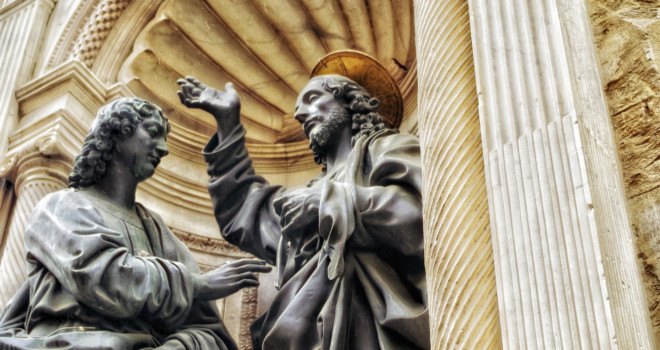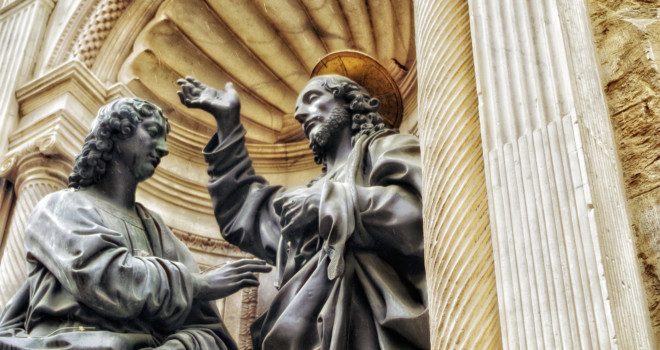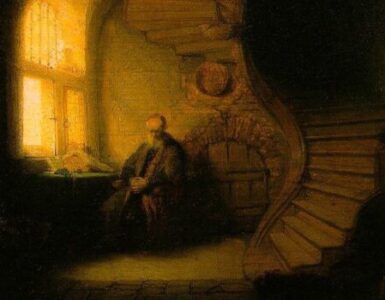Doubting Thomas & Our Lessons in Faith
Poor St. Thomas! What he expected with trepidation on the journey to Jerusalem has come to pass. The Master has been killed, and he and the other disciples have retreated in fear for their own lives. For his part, Thomas withdraws also from the company of his fellow followers, who remain locked behind closed doors.
In separating himself from the others, Thomas misses out on the opportunity to see his Lord alive again and in their midst. Locked behind the logic of his own thinking, he cannot, will not, believe it possible. Not even the glad tidings of his compatriots can shake him from his doldrums; in fact, their joy may make him feel even worse for not having been with them when the Lord returned. As a result, he remains obstinate and on his own. He wants, he needs, to see for himself. Otherwise, he will never believe it.
The Master obliges, but not until eight days later. Repeating the scene that the other apostles experienced and to which they testified, Jesus manifests Himself directly to Thomas. But unlike the first appearance, this time Jesus challenges His close companion, calling him out by name to make it real. He beckons the doubting disciple to go beyond his visual sense and grasp tactilely the truth of the Resurrection. Somehow knowing what Thomas had thought and said, the Master invites him to reach into His side, into the pierced flesh from which His Heart had poured out blood and water. Offering him that possibility, Jesus bids him to believe.
Thomas does. With or without actually touching the wounds of Jesus — the story does not say — Thomas undergoes a radical change of perspective. Seeing Jesus alive, he becomes a man of faith. He who had adamantly professed that he would never believe without tangible proof now confesses the belief that Jesus is his Lord and God. With that conversion of his own mind and heart, prompted by his visionary experience of the wounds that revealed the Sacred Heart, Thomas rejoins the other apostles as primary witnesses to the Resurrection.
From their testimony, the Christian tradition is born. The witness of those who actually saw the Risen Lord gives rise to the joyous announcement of the good news of salvation and, in turn, becomes the source of beatitude for all those in future ages who have not seen, yet have believed.
“Believing Is Seeing”
In this post-Resurrection account, the fourth Gospel narrates in straightforward fashion the change from incredulity to belief in the person of “doubting Thomas” and, by extension, the genesis of Easter faith in every Christian. That personal transformation hinges not merely on what the apostles see, but on how they see, a distinction that comes through more clearly in the Greek text of the story, which employs different terms in positing the connection between seeing and believing.
The “seeing” (from εἴ&co) of the disciples gathered on that first day of the week was, at first, merely physical. Looking upon Jesus standing before them, they “see” (v. 20) with their eyes. They notice His hands and His side as He shows Himself to them. They sense that it really is Him, the One who was crucified. This is what Thomas also demands to “see” (v. 23). Later, Jesus invites him to do just that (v. 27).
But physical sight does not suffice. Appreciating the mystery, and coming to the fullness of faith, requires more than sense awareness. Through an experience of grace, the apostles come to a more profound perception of what it means to “have seen the Lord.” They learn to “see” (from óp&co) with the discerning eyes of their hearts. Attentive to the totality of their experience, they bear witness to Him whom they have beheld (v. 25). This, too, Thomas experiences in the presence of his wounded yet living Lord and God (v. 29).
The phenomenon of Christian spirituality builds on this vision, on this transformation of the believer into a person of faith. Like the Thomas who stood apart from the community of disciples, those closed in on their own wants and needs may think that “seeing is believing.” But like the Thomas standing in the presence of the living Jesus, those open to an experience of the Sacred Heart realize that, in fact, “believing is seeing.”
Salesian Spirituality
As a Doctor of the Church, St. Francis de Sales often speaks of faith, exploring its features as a revealed gift and as a developed virtue. As a master of spirituality, however, he looks to faith as a matter of the heart more so than of the mind.
He develops this perspective when he preaches about what almost led Thomas astray. In a sermon for the Sunday after Easter in 1620 (Oeuvres, 9:308–314), the saint pictures the incredulity of the apostle in terms analogous to “libertine persons who wish to have no other laws than those which their own will dictates to them.” Basing his analysis on the thoughts of the Church Fathers, he examines three sources of this incredulity, all of which reside in the heart. The first is chagrin, that “sadness and ennui” which “obfuscates and troubles judgment” and endangers the soul by rejecting “correction and instruction and, in brief, all that is contrary to its own erroneous opinion.” The second is jealousy and vanity, by which a person seeks for himself or herself what others enjoy, believes his or her own judgment to be proper, and becomes so opinionated as not to submit to the authority that others have. The third is the despair that derives from the preceding chagrin and jealousy; it leads Thomas to set conditions on his Master’s appearance and to remain obstinate in demanding that the Lord show Himself as this lone apostle wanted.
Drawing a similar picture of Thomas’s contrariness in a sermon on the apostle’s feast day in 1622 (Oeuvres, 10:406–411), St. Francis de Sales exhorts his listeners to a greater fidelity. Wisely noting that we do not climb to complete perfection in one jump, but little by little (and by degrees), the saintly preacher reminds us that “it is necessary to have humility in order to receive that ray of divine light which is a purely gratuitous gift.” He points out how “Our Lord, by his ineffable mercy, comes a second time just for St. Thomas” and “gives him in this way some proofs of the gentleness with which he treats sinners.” Believing that the apostle did as the Lord invited him to do, St. Francis de Sales suggests that in that moment Thomas
sensed a great divine warmth, principally when he put his hand into that precious space of the treasures of Divinity, when he touched that sacred heart so ardent with love. Being so astonished, he exclaimed “O my Lord and my God” and was, at the same time, changed and rendered faithful, such that he has been a preacher of that faith like the other Apostles, and after having nobly worked for it, in the end he died for that same faith.
This Gospel narrative of Thomas’s encounter with the Sacred Heart of the Risen Lord shows the affinity between divine love and human faith. For the apostle, the connection happens through physical contact; for we who meditate on this scene, it happens spiritually. As St. Francis de Sales explains in his Treatise on the Love of God:
When God gives us faith, he enters into our soul and speaks to our mind. He does this not by way of discussion but by way of inspiration. So pleasantly does he propose to the intellect what it must believe that the will thereby receives such great complacence that it incites the intellect to consent to the truth and acquiesce in it without any doubt or opposition whatsoever.
By this loving encounter in the mind and heart, our lives are transformed, just as Thomas’s was. In the end, says St. Francis de Sales, “this assurance which human reason finds in revealed things and the mysteries of faith begins in a loving sentiment of complacence that the will takes from the beauty and sweetness of the truth that has been proposed. Hence faith includes a first start of love which the heart feels for the things of God” (Treatise, 2:14).
✠
This article is adapted from a chapter in Fr. Daily’s latest book, Behold This Heart: St. Francis de Sales and Devotion to the Sacred Heart. It is available as a paperback or ebook from Sophia Institute Press.
Also check out Fr. Dailey’s previous book, Live Today Well: St. Francis de Sales’s Simple Approach to Holiness.
image: Incredulity of St. Thomas by Andrea del Verrocchio by Stefano Chiacchiarini / Shutterstock.com













